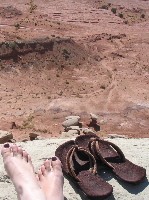Day 2 at the 210th AAS: Wide Field Surveys
Yesterday there were no big invited talks, only posters still up from Monday and three day long topical sessions: Astrophysical Ionizing Radiation Sources and their Impact on Life (think about how nearby supernovae or the orbit of the Sun around the Galaxy might have affected evolution type thing), Turbulence in Diffuse Astrophysical Environments (the majority of the talks here had "turbulence" in the title), and Wide-field Surveys in the 21st Century. I spent the day in the Wide-field Surveys room, and I got to hear a lot about how Pan-STARRS is going to be amazing, but in general I liked most of the talks because I like it when astronomy can be a "real" statistical science instead of mere stamp collecting. The two main reasons, I think, why people keep talking about Pan-STARSS here is because it's starting this year and because it is largely based in Hawaii. (In the afternoon I finally heard why I had gotten the impression that people outside of the Pan-STARRS collaboration speak of it with a bit of a sardonic or deriding tone in their voice; apparently it got its funding as a rider on some bill in Congress... was it the Iraq war bill?)
Lunch yesterday was the calmest of my meals here; I went out with just one of my officemates who is here, a former grad student from Ohio State who is now planet hunting at Space Telescope Institute (and actually finding them, unlike when he did his thesis), and another guy from STScI. It's been less true even this meeting than when I attended the 2005 winter meeting of the AAS in San Diego, but one of the nice things about these kinds of meetings is seeing people you haven't seen in a long time. I've been meeting a lot of new people, certainly, and as I guessed before coming, attendance here seems to be dominated by grad students and young postdocs.
Today will be much more interesting: my poster goes up today and I'll be attending a press conference, so stay tuned for tomorrow's report!


No comments:
Post a Comment